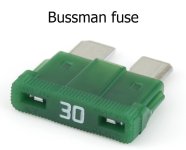Mash5
Adventurer
I guess I learn slow. It took me three tries to figure this out, so I thought I would drop it here.
When I first wired my jeep up to a Renogy 20 amp DC to DC battery charger in the bed, I had some 12g zip wire lying around, so I used it. I knew it was undersized for the job, but it worked for a bit until the rubber blade-style fuse holder under the hood of the truck melted itself and the fuse to a charred blob with an open circuit, and my charger stopped working. The fuse does not seem to have blown so much as been ripped apart by the lack of support plastic and rubber.
That is strange. Why didn’t it blow the fuse? So, I redid the wiring with 10g, which is what I should have done from the start but I again used an inline rubber fuse holder and didn’t think anything of it. After a year or so, I got the same result with a melted, charred mess.
This time, I’m going to do it right I said! I’m going to go all the way to 8g. Man, if that don’t carry the 25 amps nothing will. Again, I used a big rubber blade-style fuse holder with a 40 amp fuse.
I got 11 months of feeling like I had solved that problem once and for all until this happened.

At this point, it finally occurred to me that maybe the current was not the real problem. Maybe the under hood temperature was the issue. I still don’t feel like I fully understand what the deal is with these things, but I started looking for temperature ratings on them, and there is no such thing. I can’t find a rating from any source or manufacturer. Powerwerx, where I got the dang thing from, gave me a bunch of excuses and tried to tell me fuses should never be used in an under hood environment… Ummm, find me a car that does not have a fuse box under the hood. They never gave me a temperature rating or any reasonable answer as to why this would happen.
My solution will be to try MRBF Terminal Fuses mounted directly at the battery terminal. They are rated for up to 125c, which should work better under the hood. Maybe more importantly, they don’t have a bunch of fuel-like stuff warped around the high-resistance part of the circuit.
The more I think about the inline fuse holders like this, the more I hate the design.
When I first wired my jeep up to a Renogy 20 amp DC to DC battery charger in the bed, I had some 12g zip wire lying around, so I used it. I knew it was undersized for the job, but it worked for a bit until the rubber blade-style fuse holder under the hood of the truck melted itself and the fuse to a charred blob with an open circuit, and my charger stopped working. The fuse does not seem to have blown so much as been ripped apart by the lack of support plastic and rubber.
That is strange. Why didn’t it blow the fuse? So, I redid the wiring with 10g, which is what I should have done from the start but I again used an inline rubber fuse holder and didn’t think anything of it. After a year or so, I got the same result with a melted, charred mess.
This time, I’m going to do it right I said! I’m going to go all the way to 8g. Man, if that don’t carry the 25 amps nothing will. Again, I used a big rubber blade-style fuse holder with a 40 amp fuse.
I got 11 months of feeling like I had solved that problem once and for all until this happened.

At this point, it finally occurred to me that maybe the current was not the real problem. Maybe the under hood temperature was the issue. I still don’t feel like I fully understand what the deal is with these things, but I started looking for temperature ratings on them, and there is no such thing. I can’t find a rating from any source or manufacturer. Powerwerx, where I got the dang thing from, gave me a bunch of excuses and tried to tell me fuses should never be used in an under hood environment… Ummm, find me a car that does not have a fuse box under the hood. They never gave me a temperature rating or any reasonable answer as to why this would happen.
My solution will be to try MRBF Terminal Fuses mounted directly at the battery terminal. They are rated for up to 125c, which should work better under the hood. Maybe more importantly, they don’t have a bunch of fuel-like stuff warped around the high-resistance part of the circuit.
The more I think about the inline fuse holders like this, the more I hate the design.

